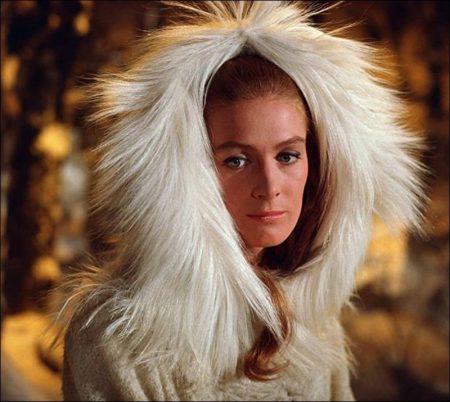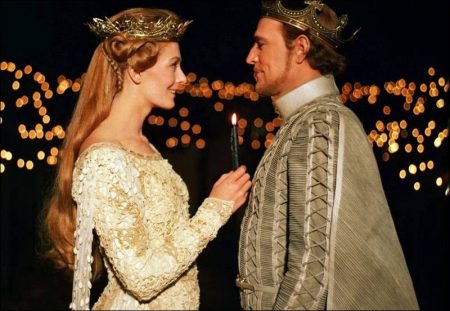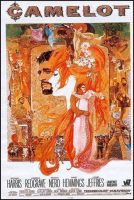Camelot movie synopsis. Merlin taught King Arthur well. He establishes the perfect kingdom of Camelot, the best knights in the world at the Round Table, and even finds himself a kind, loving wife in Queen Guenevere. Then, along comes the French knight, Lancelot. At first hated by all, he eventually proves himself and becomes the King’s best friend and the best knight of the Round Table. He also becomes the Queen’s lover, no matter how guilty both feel. Alas, Camelot cannot last! For Mordred, the king’s treacherous illegitimate son, catches on, and works to undo everything Arthur worked for.
Camelot is a 1967 American musical drama fantasy film directed by Joshua Logan and starring Richard Harris as King Arthur, Vanessa Redgrave as Guenevere, and Franco Nero as Lancelot. The film is an adaptation of the 1960 musical by Alan Jay Lerner and Frederick Loewe. Lerner also wrote the screenplay.
In April 1961, the rights to produce a film adaptation of Camelot were obtained by Warner Bros. with Lerner attached to write the screenplay. However, the film was temporarily shelved as the studio proceeded to adapt My Fair Lady into a feature film adaptation. In 1966, development on the film resumed with the hiring of Joshua Logan as director. Original cast members Richard Burton and Julie Andrews were approached to reprise their roles from the stage musical, but both declined and were replaced with Harris and Redgrave. Filming took place on location in Spain and on the Warner Bros. studio lot in Burbank, California.
The film was released on October 25, 1967. It received mixed to negative reviews from film critics and was a commercial failure. Nevertheless, the film was nominated for five Academy Awards and won three for Best Score, Best Art Direction, and Best Costume Design.

About the Filming
As his first film credit, 29-year-old Australian set designer John Truscott, who created the sets for the London and Melbourne stage productions of Camelot, was hired as production designer. According to Logan, Truscott envisioned the visual design that resembled “neither Gothic or Romanesque but an in between period, suggesting a legendary time”.
The Castillo de Coca was the inspiration for the film’s production design, which was re-created on the studio backlot in Burbank, California. The finished castle became the largest set ever constructed at the time, measuring 400 by 300 feet, and nearly 100 feet with the reported cost covered half a million dollars. Logan later explained that “it was absolutely necessary since we expect to do everything right in this picture—even to matching Spanish and Hollywood cobblestones.”
In September 1966, the film began shooting on location in Spain intended for a 30-day shooting schedule. For the exterior sets, Logan selected seven castles on the country’s mainland and another one on the island of Majorca, of which included the Alcázar of Segovia that was used as Lancelot de Luc’s castle and the Medina del Campo. However, the location shoot experienced setbacks due to the country’s rainfall and high temperature in which filming finished 12 days behind schedule.
In total, the shoot yielded 30 minutes of usable footage. With production underway, Jack L. Warner decided that Camelot would be his last film he would produce for the studio. On November 14, 1966, he sold a substantial share of studio stock to Seven Arts Productions. The sale was finalized on November 27, which yielded to approximately $32 million in cash.
Following the location shoot in Spain, the filming unit took a seven-week hiatus until Vanessa Redgrave completed her role in The Prime of Miss Jean Brodie. By then, fifteen of the studio’s 23 stage sets were occupied for Camelot. Filming was further complicated when Richard Harris required 12 facial stitches after he fell down in his shower. Against the doctor’s orders, the stitches reopened when Harris went out to party which further delayed his recovery. Plastic surgery was later applied to disguise the wound.
Camelot (1967)
Directed by: Joshua Logan
Starring: Richard Harris, Vanessa Redgrave, Franco Nero, David Hemmings, Lionel Jeffries, Laurence Naismith, Estelle Winwood, Gary Marshal, Peter Bromilow, Nicolas Beauvy, Sue Casey
Screenplay by: Alan Jay Lerner
Production Design by:
Cinematography by: Richard H. Kline
Film Editing by: Folmar Blangsted
Costume Design by: John Truscott
Set Decoration by: John Brown
Art Direction by: Edward Carrere
Music by: Frederick Loewe, Alfred Newman
MPAA Rating: None.
Distributed by: Warner Bros. Pictures, Seven Arts
Release Date: October 25, 1967
Views: 262

